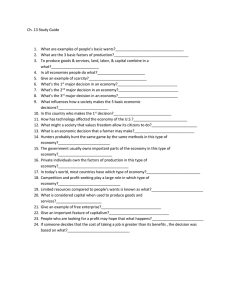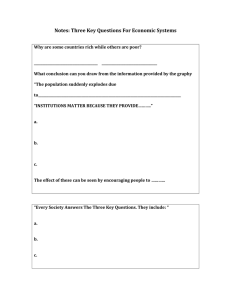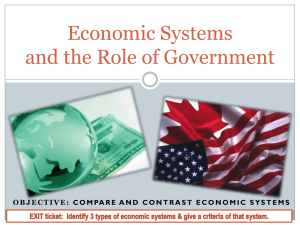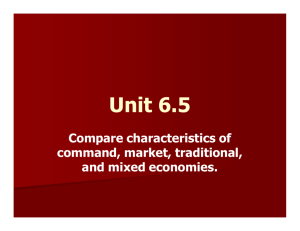BRO Time Review
advertisement
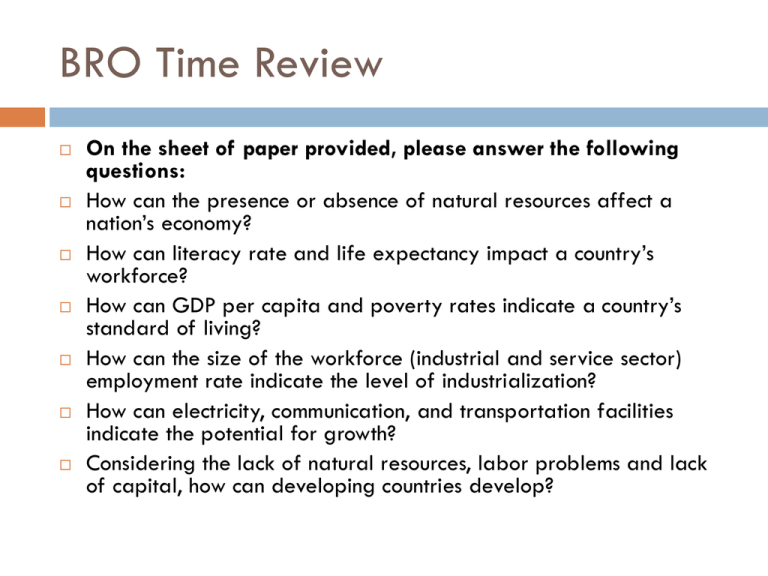
BRO Time Review On the sheet of paper provided, please answer the following questions: How can the presence or absence of natural resources affect a nation’s economy? How can literacy rate and life expectancy impact a country’s workforce? How can GDP per capita and poverty rates indicate a country’s standard of living? How can the size of the workforce (industrial and service sector) employment rate indicate the level of industrialization? How can electricity, communication, and transportation facilities indicate the potential for growth? Considering the lack of natural resources, labor problems and lack of capital, how can developing countries develop? Previously… Economy- organized way a nation provides for the nation’s needs and wants Economics- management of production, distribution, and consumption of goods Economic resources Human Natural Capital Scarcity: Unlimited Wants – Limited Resources = Scarcity ECONOMIC SYSTEMS AND THE ROLE OF GOVERNMENT Marketing Co-Op 3 Economic Questions That Must Be Answered The way they answer them defines the nations economic system 1. What goods and services should be produced? 1. How should the goods and services be produced? 1. For whom should the goods and service be produced? Economists have classified economic systems into three broad categories 1. 2. 3. Traditional Economies Market Economies Command Economies Traditional Economies Traditions and rituals answer the what, how and for whom Answers are often based on religious or cultural practices and ideals What: little choice as to what to produce How: bound to tradition, they continue what their families have done for generations For whom: tradition regulates who will sell and to whom Market Economies There is NO government involvement Individuals own the means of production Businesses compete for customers What: Consumers decide what will be produced by the purchases they make – poor products will not be purchased How: Companies must find the most efficient means of production to increase profits For whom: the people with the money – this motivates people to work and make money Command Economies The country’s government makes economic decisions and decides what when and how much will be produced and distributed What : one person (usually a dictator) decides what will be produced How: government decided who will produce it and how For Whom: government decides who will get what products In principle, wealth is shared equally among all to ensure everyone’s basic needs are met Mixed Economies No economy is purely ONE economic system The USA is a mixed economy, leaning toward a market economy In a pure market economy there is NO government involvement at all The US government has some involvement, but is strictly managed by laws and regulations Capitalism Characterized as encouraging : Marketplace competition Private ownership of businesses Government cares about its people and tries to take care of those that can not care for themselves Although the number of social services does not match that of a socialist economy Communism Characterized by: Total government control (they decide who will work where, how much they are paid, etc.) Theoretically this ensures everyone will have their basic needs met There is nothing to drive people to better themselves or to work hard Examples: Cuba, North Korea and China Socialism Similar to capitalism, only there is much more government involvement in the economy More social services to ensure a good standard of living Taxes are much higher to help finance government services Government runs key industries (telecommunications, natural resources, transportation and banking) Examples: Canada, Germany and Sweden HOW IS THE US ECONOMY REGULATED OR PROTECTED? The Federal Reserve What is the Federal Reserve? The Federal Reserve is the central banking system of the United States, located in Washington DC The Federal Reserve’s duties include: Conducting Monetary Policy Regulating banking institutions Protecting credit rights of consumer Maintaining the stability of our financial system Providing Financial Services to the US Government Federal Reserve Video
